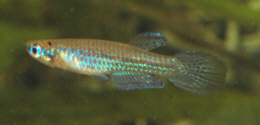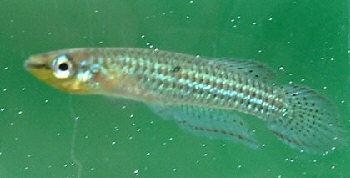Aphyoplatys duboisi (Poll 1952)

Wild pair from a Congo import into the UK July 2022
| Meaning of Name |
After the Belgian chemist & aquarist Dubois who bred them in 1952. | ||||
| First Description |
Poll M 1952 c | ||||
| Size |
3·5 cm (Huber in Killie Data). 3 cm in Wildekamp 'A World of Killies' Vol. 1. | ||||
| Meristics |
D = 9-10, A = 14-16, ll = 25-26 Poll 1952. | ||||
| Karyotype |
n = 24 (26 arms) Scheel & Romand 1981. See (Killie Data). | ||||
| Sub-Genus |
none | ||||
| Group |
A monospecific genus. | ||||
| Synonyms |
Epiplatys duboisi
Poll 1952. | ||||
Populations
|
Kungu - Collected close to this location in western Zaire 1935 by Schouteden. N'do - In the surrounding area of Kinshasa, Zaire. Collected in 1951 by Dubois. Lukunga Marshes - Zaire. Collected by Lambert in 1970. Mbamou - An island in the Zaire River. Collected by Huber in 1978 & assigned the code JH 179. JH 124 - Collected by Huber in 1978 30 km east of Boundji in central Congo. Ntokou - In the Likouala / Mossaka River. Collected by Huber in 1978 & assigned the code JH 133. JH 106 - Collected by Huber in 1978 near Gamboma in the N'kenni River, southern Congo. JH 125 - Collected by Huber in 1978 50 km north of Obouya at the Vouma bridge. JH 110 - South of Oyo near the Alima ferry in central Congo. | ||||
| Type Locality |
Leopoldville, a small stream near to N'do (N'dolo in Hoedemans book) which is close to Kinshasa. | ||||
| Distribution |
Large distribution area around the upper to mid Zaire River dranage. | ||||
| Habitat |
Streams & small rivers. Stagnant areas over
leaf or mud substrate. Water depth measured at 30 cm. This sp. is found
at lower water levels. | ||||
| Distinguishing Characteristics | Cannot really be confused with other killies. Adult males show pointed caudal fins. The males body has regular spots with the Oyo population exhibiting chevron markings on the body pointing to the caudal. | ||||
| Colour/Pattern Variability | Not regularly imported although some commercial shipments contain this sp. Given it's large distribution area a wide variability could be expected. The photos & line drawings I have seen show basically the same fish save chevron markings in the Oyo population. | ||||
| History |
Poll described this species from 11 fish caught in the Stanley Pool (now Pool Malebo) area of Congo. In 1967 Clausen placed the fish in a new genus - Aphyoplatys. Imported by BKA Species Import in June 1974. Regularly found in commercial imports from Kinshasa. | ||||
| Breeding Notes |
From my experience with wild fish I found a bag containing over 50 fish laid in bottom mops in a 2' square tank on system with roots from a devils ivy in the tank. I took off about 20 eggs per day. Eggs were quite large for the size of fish but fry were tiny & put into shallow (25mm) green water to start. Wildekamp in 'World of Killies'
Vol.1 considered them sensitive to any form of pollution & regarded
regular water changes as a necessity. John Boylan made this observation
on the AKA Newsgroup Nov.2003..... Tony Terceira made this comment
on the AKA Newsgroup Nov. 2003... Reported on Killie
Data as being a sp. for the expert to breed. First food for fry
needs to be Paramecium. | ||||
| Diameter of Egg | 1·1 mm. | ||||
| Remarks |
It has been observed that males 'dance' in front
of females during courtship. |

